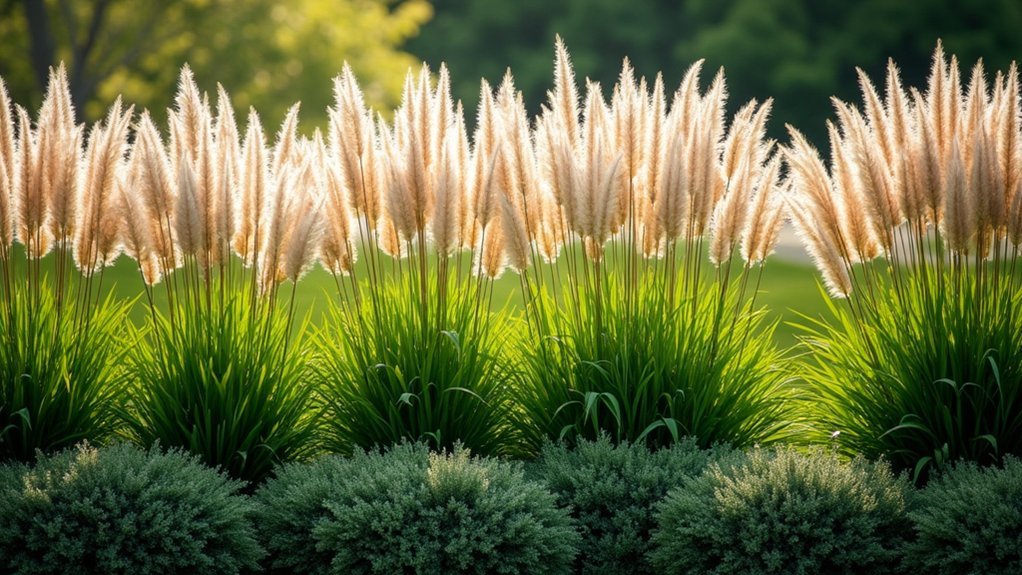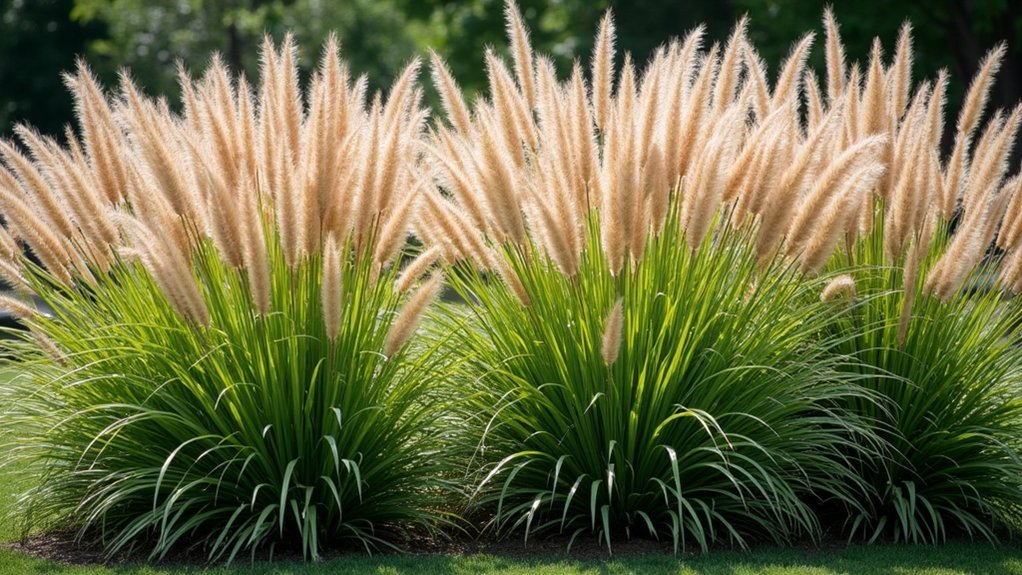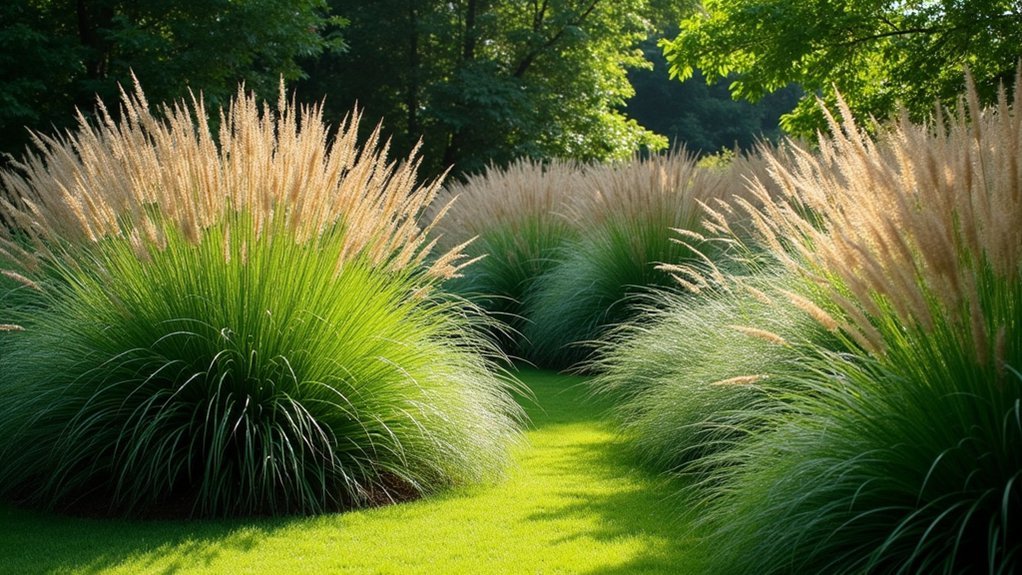Ornamental grasses make exceptional privacy screens with their height, quick growth, and low maintenance. For maximum privacy, choose giant miscanthus (8-12 feet), elephant grass (8-10 feet), or silver grass (5-12 feet). Plant them 3-5 feet apart in staggered rows for denser coverage. Most varieties mature within two seasons and offer year-round screening when combined strategically. You’ll benefit from natural aesthetics, sound reduction, and wildlife support while creating dynamic outdoor spaces that change beautifully through seasons.
Why Ornamental Grasses Excel as Living Privacy Screens

When seeking alternatives to traditional privacy solutions, ornamental grasses stand out as exceptional living screens that combine beauty with functionality. Unlike rigid fencing, these grasses offer a natural aesthetic that blends seamlessly with your landscape while providing the seclusion you desire.
You’ll appreciate their economic advantage—they’re notably more cost-effective than installing fences or establishing hedges. Their rapid growth means you won’t wait years for privacy, as most varieties reach maturity within two seasons. They’re also remarkably low-maintenance compared to hedges that require regular trimming.
Beyond privacy, you’re making an environmentally conscious choice. Your grass screen will support local pollinators, prevent soil erosion with extensive root systems, and create wildlife habitats—all while adding year-round visual interest to your garden. Tall varieties like Pampas Grass create impressive barriers with their 8 to 12 feet height and dramatic plume displays.
Top 5 Tallest Ornamental Grasses for Maximum Privacy
For homeowners seeking the ultimate natural privacy solution, height becomes the defining factor. Giant Miscanthus leads the pack, towering 8-12 feet with a dense clumping form that creates an effective visual barrier across 4-6 foot spreads.
Elephant Grass follows closely at 8-10 feet, forming dense thickets with wide, blade-like foliage ideal for large-scale screening.
Silver Grass varieties reach 5-12 feet with decorative silvery plumes adding aesthetic appeal in fall. This versatile option thrives particularly well in US hardiness zones 5-7 with its soft, naturalistic texture.
Big Bluestem stands 4-8 feet tall with striking reddish-tan autumn coloration while providing valuable bird habitat.
Switchgrass, particularly the ‘Northwind’ variety, grows beyond 6 feet with an upright habit and golden-red fall hues, thriving in various soil conditions with minimal care.
Best Ornamental Grasses for Year-Round Screening

Creating effective year-round privacy screens requires selecting ornamental grasses that maintain their structural integrity throughout all seasons.
For consistent coverage, evergreen sedges (Carex spp.) offer continuous privacy without fall cutting, while clumping bamboo varieties like Fargesia provide non-invasive screening that reaches full height within 2-3 seasons.
In colder regions, Switch Grass ‘Northwind’ stands strong under snow loads in Zones 4-9, while Porcupine Grass delivers distinctive horizontal banding and upright structure.
For warmer climates, Muhly Grass thrives in Florida, reaching 5 feet with salt-tolerance, and Pampas Grass creates dramatic year-round barriers in Zones 7-11. These options provide ecological diversity while creating effective screening solutions for your garden landscape.
For ideal density, plant bamboo 3-5 feet apart or smaller grasses at 18-24″ spacing.
Consider container planting for running bamboo varieties to prevent spreading.
How to Plant Ornamental Grasses for an Effective Privacy Barrier
Establishing an effective ornamental grass privacy screen requires careful planning and proper planting techniques to guarantee long-term success.
Start by selecting clumping varieties that won’t aggressively spread, ensuring they’ll reach sufficient height (5-12 feet) for privacy.
Prepare your site by testing soil pH (aim for 6.0-7.0) and removing competing vegetation within a 3-foot radius.
Loosen soil 12-18 inches deep and incorporate 2-3 inches of compost to improve drainage.
Plant in spring or early fall, spacing grasses 3-5 feet apart depending on mature width.
Dig holes twice the root ball width, positioning the crown slightly above soil level.
Water thoroughly after planting, then mulch to retain moisture.
For denser screening, stagger your rows in a triangular pattern rather than straight lines.
Consider incorporating Pampas Grass for immediate results since it reaches full height within months, providing quicker privacy than slower-growing varieties.
Drought-Tolerant Ornamental Grasses for Low-Maintenance Screens

Drought-tolerant ornamental grasses provide the perfect solution for homeowners seeking privacy without excessive watering demands.
These resilient plants thrive in various soil conditions while providing quick coverage and year-round visual interest.
Consider these standout options for your low-maintenance privacy screen:
- Switchgrass delivers robust height and drought resistance, creating an effective natural barrier.
- Giant Sacaton reaches impressive heights with minimal watering, perfect for substantial privacy needs.
- Muhly Grass adapts to diverse conditions and produces stunning pink plumes in fall.
- Fountain Grass offers graceful arching form and tolerates dry spells once established.
You’ll appreciate how these grasses reduce maintenance time while supporting local wildlife.
For enhanced visual appeal and texture throughout the changing seasons, consider combining grasses with flowering perennials that complement their natural growth habits.
Their ability to withstand harsh weather guarantees your privacy screen remains effective through changing seasons.
Combining Different Grasses for Layered Privacy Effects
While a single variety can provide basic coverage, strategically combining different ornamental grasses transforms an ordinary privacy screen into a dynamic, textured landscape.
By mixing species with varying heights, you’ll create depth that enhances both privacy and visual appeal.
Pair tall Big Bluestem (reaching 6 feet) with mid-height Switch Grass to fill gaps, then add Muhly Grass for its stunning pink fall plumes.
Incorporate Zebra Grass for its striking variegated foliage and compact clumping habit.
When planning your combination, consider each grass’s moisture needs, sun exposure requirements, and growth patterns.
This thoughtful mixing not only improves screen effectiveness but also provides year-round interest, wildlife habitat, and seasonal color changes that evolve throughout the seasons.
Ornamental Grasses That Thrive in Shaded Boundary Areas

While establishing privacy in shaded areas presents unique challenges, you’ll find shade-tolerant bamboo varieties offer exceptional screening capabilities even with limited sunlight.
Japanese Forest Grass, with its cascading form and striking variegation, provides lower-level privacy that works beautifully beneath taller woody plants along boundary lines.
You can create effective dappled light screens by strategically placing these shade-loving grasses where they’ll receive filtered morning sun while protecting more sensitive plants behind them. For taller privacy needs, consider using Feather Reed Grass with its vase-like shape that creates natural vertical interest while thriving in shady, boggy conditions.
Shade-Tolerant Bamboo Varieties
Although typically associated with full sun environments, several bamboo varieties thrive beautifully in shaded boundary areas, making them perfect candidates for privacy screens where light is limited.
Clumping bamboos offer the best solution as they’re non-invasive while creating dense privacy barriers.
- Fargesia varieties excel in shade, originating from western China with excellent cold tolerance and lush foliage.
- Indocalamus features delicate leaves that create gentle movement and filtered light effects in shaded spaces.
- Gracilis Bamboo forms straight, dense clumps perfect for narrow boundaries with limited sunlight.
- Chusquea provides attractive culms and maintains vigor even in cooler, shadier environments.
Most shade-tolerant bamboos require minimal maintenance once established, though regular watering during establishment and occasional pruning will maintain their ornamental appeal while maximizing privacy benefits. The density of foliage significantly affects how effective these bamboo varieties will be as visual barriers in your landscape.
Japanese Forest Grass
Beyond bamboo options, Japanese Forest Grass (Hakonechloa macra) offers another exceptional choice for creating privacy in shaded boundary areas. This graceful perennial thrives in partial sun to shade with its distinctive arching growth habit.
You’ll find this versatile grass particularly effective when planted in staggered patterns, creating a cohesive screen that typically reaches 12-24 inches tall. Popular cultivars like ‘Aureola’ showcase stunning golden variegation, while ‘All Gold’ and ‘Beni Kaze’ provide alternative color options for your screening needs.
Japanese Forest Grass prefers moist, well-drained soil rich in organic matter and performs best in hardiness zones 5-9. Its copper-orange fall coloration creates an additional seasonal interest point for your privacy screen. It’s an ideal solution for small spaces that need year-round visual interest.
For maximum impact, combine it with other shade-loving plants to create mixed borders with naturalistic appeal.
Creating Dappled Light Screens
Creating privacy screens in shaded areas presents unique challenges that require carefully selected ornamental grasses adapted to lower light conditions. Most shade-tolerant grasses perform best with 2-4 hours of morning sunlight or in locations with dappled light that mimics woodland environments.
For successful shaded privacy screens, consider these adaptable options:
- Northern Sea Oats (Chasmanthium latifolium) thrives in moist, shady borders, reaching 2-3 feet with distinctive drooping seedheads.
- Feather Reed Grass (Calamagrostis) maintains upright form in partial shade and creates uniform 3-5 foot screens.
- Tufted Hair Grass (Deschampsia) forms elegant 2-3 foot clumps with airy panicles even in low light.
- Forest Sedge varieties (Carex) offer non-grass alternatives for deeper shade, forming dense 1-2 foot mounds.
Plant in staggered rows and maintain consistent moisture for ideal growth in shaded conditions. Before installation, it’s essential to evaluate your site’s specific soil conditions to ensure proper plant establishment and long-term success of your privacy screen.
Creating a Sound Buffer With Strategic Grass Placement

When planted strategically, ornamental grasses serve as more than just a visual barrier—they’re excellent sound buffers for your outdoor space.
Position tall varieties like Big Bluestem and Switchgrass near noise sources to mitigate sound pollution. Consider prevailing wind directions when placing your grasses, as this enhances sound diffusion.
For maximum effectiveness, plant your grasses densely and in layers of varying heights. This approach not only absorbs more sound but adds visual depth to your landscape.
Combine ornamental grasses with other dense foliage plants or integrate them with existing structures like fences for enhanced sound-blocking capabilities.
Tall options like Ravenna Grass (reaching 12 feet) and Pampas Grass with their substantial plumes offer exceptional sound buffering properties while creating dramatic visual impact in your yard.
Seasonal Maintenance Tips for Your Grass Privacy Screen
Maintaining the beauty and effectiveness of your ornamental grass privacy screen requires consistent seasonal attention throughout the year. Proper timing is essential for cutting back—trim warm-season varieties in fall or by late spring, while cool-season grasses do best with early spring maintenance.
Beautiful privacy screens of ornamental grass demand year-round seasonal care, with proper timing for cutting back different varieties essential for maximum effectiveness.
Before tackling trimming jobs, gather the right tools:
- Bundle grasses with twine before cutting to simplify cleanup
- Use sharp, clean pruning shears for smaller varieties and hedge trimmers for larger specimens
- Remove dead or diseased foliage promptly to prevent spread
- Cut most grasses to about 4-6 inches above ground level
Apply slow-release fertilizer in spring to support healthy growth without causing weak stems that could compromise your privacy screen. Remember to divide your grasses every few years to prevent center die-off and maintain vigor, typically best done in early spring when new growth begins appearing.
Pairing Ornamental Grasses With Other Plants for Enhanced Privacy
While ornamental grasses create impressive privacy screens on their own, pairing them with complementary plants can transform your barrier into a dynamic, multi-layered landscape.
You’ll achieve fuller coverage by combining tall grasses like Ravenna or Big Bluestem with structural elements such as clumping bamboo or columnar evergreens that fill gaps and provide year-round screening.
Adding drought-tolerant companions like Russian sage or wildlife-friendly berry producers guarantees your privacy screen remains beautiful across seasons while serving multiple functions in your garden design.
Layering For Complete Coverage
Creating a truly effective privacy screen requires more than simply planting a single row of ornamental grasses. By strategically layering different plants, you’ll achieve ample coverage that maintains privacy year-round while creating visual interest.
The key to successful layering involves:
- Positioning taller grasses like Pampas or Big Bluestem toward the back, with mid-height varieties like Switchgrass in the middle.
- Incorporating evergreen shrubs as a backdrop to maintain coverage during winter dormancy.
- Using the tiered planting approach with shorter grasses and perennials at the edges.
- Considering growth patterns—plant clumping varieties closer together than spreading types.
Remember to account for your local climate when selecting combinations.
The Susan Schreibman method of placing mid-level shrubs behind ornamental grasses works particularly well, creating depth while ensuring no gaps appear as seasons change. Adding Zebra Grass with its variegated foliage can provide beautiful visual contrast while maintaining the 5-8 foot height needed for effective screening.
Companion Plant Selection
The perfect privacy screen doesn’t rely on ornamental grasses alone but flourishes when thoughtfully paired with companion plants that enhance both screening capabilities and aesthetic appeal.
When selecting companions, focus on plants with similar hardiness zones and soil requirements to guarantee they thrive alongside your grasses.
Combine different textures by adding perennials like coneflowers or structural elements like small shrubs.
For maximum impact, integrate pollinator-friendly plants such as bee balm or butterfly bush, which attract beneficial insects while adding visual interest.
Consider drought-tolerant options like lavender or yucca if water conservation is important.
Native plant integration supports local biodiversity and often requires less maintenance.
For year-round interest, incorporate plants with varied blooming seasons or winter appeal to complement the ornamental grasses’ seasonal changes.
Seasonal Interest Combinations
Building on our companion plant principles, thoughtful seasonal combinations elevate privacy screens from mere barriers to year-round visual masterpieces.
Creating diverse, multi-season interest requires strategic pairing of ornamental grasses with complementary plants that offer contrasting textures, colors, and bloom times.
- Pair towering Pampas Grass (10-12 feet) with fragrant Lavender for a sensory-rich boundary that shifts beautifully through seasons.
- Combine Switch Grass with Hydrangeas for dramatic seasonal color shifts—summer greens giving way to autumn burgundies alongside hydrangea’s evolving blooms.
- Mix Muhly Grass with Buddleia to create a butterfly haven while maintaining substantial privacy.
- Integrate Feather Reed Grass with evergreen English Ivy for continuous coverage when deciduous elements retreat in winter.
These thoughtful combinations guarantee your privacy screen remains functional and visually engaging regardless of season.
Design Inspiration: Real-World Ornamental Grass Privacy Screens
When homeowners transform their outdoor spaces with ornamental grasses, they’re not just installing privacy screens—they’re creating living works of art.
You’ll find backyard retreats where zebra grass creates 8-foot natural walls, offering both seclusion and sound reduction from neighboring properties.
In front yards, strategic plantings of fountain grass with their elegant plumes shield unsightly views while maintaining curb appeal.
Many homeowners combine silver grass with New Zealand flax to create stunning visual contrast that reflects sunlight.
Unlike rigid fencing, these natural barriers section off spaces while still feeling integrated with the landscape.
Natural green dividers breathe life into garden rooms while maintaining the landscape’s organic flow.
You’ll notice how dense plantings fill in quickly, often reaching maturity within two seasons—far faster than traditional hedge options, all while requiring less maintenance and investment than constructed alternatives.
The versatility of miscanthus grass landscapes provides impressive height and density that makes them ideal choices for creating effective privacy barriers between properties.
Frequently Asked Questions
How Quickly Can Ornamental Grasses Be Removed if Needed?
You can remove small grass clumps in 1-2 hours, while mature specimens take 2-4 hours. DIY removal costs $0-$50, while professional services complete larger areas in 1-3 days for $300-$800+.
Do Ornamental Grass Screens Attract Unwanted Pests or Insects?
No, most ornamental grasses actually repel common pests. You’ll find varieties like Zebra Grass, Switchgrass, and Feather Reed Grass naturally resist deer, rabbits, and insects without requiring chemical treatments.
Can Ornamental Grasses Damage Foundations or Underground Utilities?
No, you won’t worry about foundation damage with ornamental grasses as they have shallow root systems. They’re actually beneficial near foundations and rarely interfere with underground utilities due to their non-invasive roots.
How Do Ornamental Grasses Compare to Traditional Fencing Costs?
You’ll find ornamental grasses typically cost less upfront than traditional fencing. While grasses run $3-15 per plant (needing 5-10 per linear foot), wood fencing costs $15-45 and chain-link $10-20 per linear foot installed.
Are Ornamental Grass Privacy Screens Permitted in HOA Communities?
In HOA communities, you’ll typically need pre-approval for ornamental grass privacy screens. They’re often permitted if they’re non-invasive, meet height restrictions, follow location guidelines, and you maintain them according to community standards.
In Summary
You’ve got plenty of stunning ornamental grasses to choose from for your privacy screen. Whether you need year-round coverage, drought tolerance, or maximum height, there’s a perfect grass for your situation. With proper planning and maintenance, you’ll enjoy not just privacy but also beautiful movement, texture, and sound in your outdoor space. Your grass screen will transform your yard into a secluded, natural retreat.





Leave a Reply